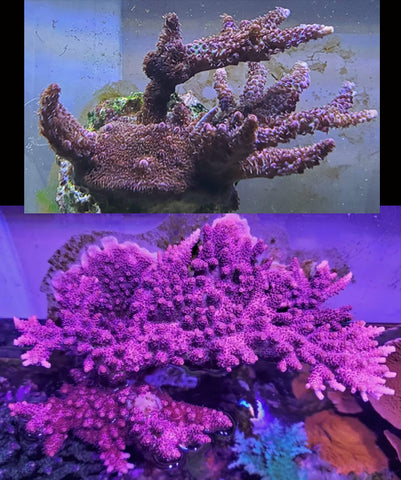Did you know it's just as important to acclimate new coral to your lighting as it is to have proper water parameters? Any time you move a coral from one place to another, even within the same tank, keep in mind that the coral will need time to adjust to the new lighting intensity and flow rate and pattern there. Newly shipped corals are especially prone to "bleaching" from being exposed to direct light too quickly.
How to light acclimate a coral
When you receive your new coral, follow our easy acclimation guide. Turn the aquarium lights off before placing your coral in the new tank. Keep the lights off until the next morning.
A good place for new corals is at the very far left or right side corners of the aquarium where the light is least intense. If the frag has a plug, you can place a frag rack in a shady spot on the side of your tank for new corals. If it has a flat bottom, you can place it on the substrate (avoid letting sand collect on the coral).

If you want to mount your coral to its final placement right away, you can dim the light instead. Some LED lights come with an "acclimation mode." The standard is to start the light acclimation by dimming the lights by about 50%, slowly increasing the intensity by very small increments over the course of 30 days.
If you don't have LED lights with an acclimation mode, you can shade the coral by cutting out circles of mesh window screen and stacking them above the coral on the lid of your tank so that they only shade that coral. Each week remove one of the stacks.

If your lights have a simple on/off switch and can't be dimmed, you can cut back the number of hours your lights are on during the day temporarily. Add an hour to the daylight hours each week for a month until the daylight hours are back to normal (usually 8 to 12 hours total, with actinic light coming on one hour before the white, and staying on one hour after). Another method is to adjust the height of the lights so they're further away from your water's surface. Over the course of the month, slowly adjust the height until they're in their original position.
Of course, you should observe your coral during acclimation and adjust as needed. It takes a bit of experience and focused observation to know when a coral is stressed. A coral that is pale, white, or translucent is "bleached" and should not be exposed to direct lighting. Bleaching happens when a coral is stressed, usually by bright light or heat, and loses its symbiotic zooxanthellae. Even a coral that is completely white can recover given proper conditions, indirect light, lots of coral food, and patience.
an example of a pale, bleaching coral that needs to be moved to a shady spot and fed often for recovery.

What to expect when you're expecting new coral
Shipping is the most stressful event in these animals' lives, even exponentially more stressful than chopping them up and gluing them to rocks! This is why we need to give them extra care and consideration when they first arrive. Luckily, most coral, especially aquacultured coral, is much hardier than expected as long as you know how to acclimate them properly.
Keeping this in mind, it's normal/expected for coral to arrive with less color after shipping. It's also common for smaller/younger frags to have a more subdued color than the mature mother colony they were cut from. Over time with proper care, conditions, and nutrition, these young frags will color up to look more like their parent colony.

Corals can look completely different depending on the light intensity. A "Mummy Eye Chalice" will be bright yellow under intense light, but deep neon orange under less intense light.

A Sunkist Oxypora will be dull green under intense light, but will be a beautiful velvety orange in the lower areas of a brightly lit reef tank. An Acropora coral might be dark green as a frag, but pink as an adult colony. A dark green Acropora colony can even turn a completely different color under a different type or intensity of lighting. It depends a lot on the health and concentration of the coral's many tiny symbionts and how the environment and feeding encourages the coral's coloration.
This Acropora turned bright pink after an upgrade to a newer "high end" lighting system.

This Red Montipora Cap grew into a stunningly bright show piece with proper light acclimation and slow light intensity increase.

This Biota Helen's Smoothskin Acropora was grown in Palau from a bright blue mother colony. Young, small frags tend to be more green, and it's natural for coral during shipping to lose a little color, but they tend to color up again quickly. Here's a collage of this coral from the day it arrived until about one year later. It's hard to imagine the coral in the first picture is the same exact coral in the last picture.

If you think your coral arrived DOA, please read our DOA policy here.
There is no instant gratification when it comes to coral keeping, but that's half the fun of this hobby! The coral keeper must provide an environment similar to its natural habitat in order for it to thrive, and that isn't always easy. Of course, aquacultured corals are hardier and better suited to home aquarium life than wild caught corals. With patience, consistency, and research, you will be a successful coral grower!

